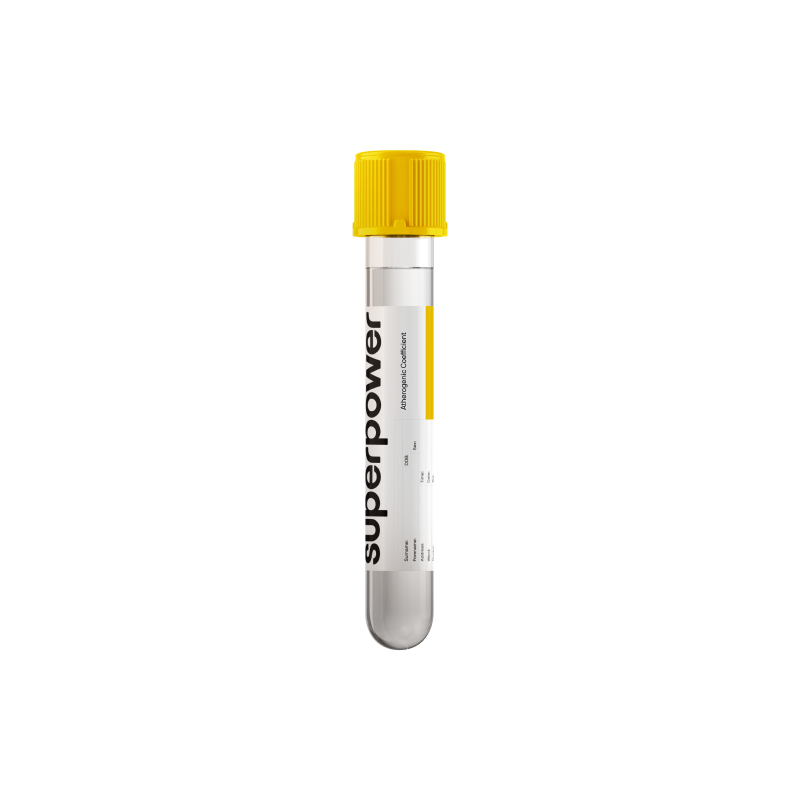A simple ratio of non-HDL to HDL cholesterol that shows the balance between artery-active and protective lipoproteins—helping you refine cardiovascular risk and guide action with clarity.
Key Benefits
- See your artery-clogging balance; lower values indicate less atherogenic risk.
- Understand the measure: non‑HDL cholesterol divided by HDL cholesterol.
- Spot hidden lipid imbalance even when LDL looks acceptable, revealing residual risk.
- Clarify insulin-resistance patterns when triglycerides are high or HDL runs low.
- Guide lifestyle and treatment discussions alongside LDL‑C, non‑HDL‑C, triglycerides, and ApoB.
- Track response to diet, exercise, weight loss, and medications using one ratio.
- Support cardiovascular prevention by reflecting total atherogenic burden beyond LDL.
- Best interpreted with overall risk factors, ASCVD calculator, and your clinician’s guidance.
What is Atherogenic Coefficient?
Atherogenic Coefficient is a calculated index from a standard lipid panel that compares the cholesterol carried by potentially artery-clogging particles to the cholesterol carried by protective HDL. It is derived from total cholesterol and HDL cholesterol, effectively contrasting non-HDL cholesterol (cholesterol within LDL, VLDL, IDL, and remnant lipoproteins—apolipoprotein B–containing particles) with HDL cholesterol. These lipoproteins originate in the liver and intestine and circulate in the blood to transport fats and cholesterol between tissues.
This coefficient captures the balance between cholesterol delivery into artery walls and cholesterol removal from them. It reflects the interplay of atherogenic lipoproteins that can deposit cholesterol in the arterial lining (atherogenesis) and HDL-mediated clearance of cholesterol back to the liver (reverse cholesterol transport). By compressing the behavior of multiple lipoprotein classes into a single ratio, it summarizes the net “traffic” of cholesterol in the vascular system and the biological context in which plaques can form or stabilize. In this way, Atherogenic Coefficient functions as an integrative snapshot of atherogenic burden and protective capacity within the circulating lipid profile.
Why is Atherogenic Coefficient important?
Atherogenic Coefficient (AC) captures the balance between cholesterol that tends to deposit in arteries and the HDL that helps clear it. Calculated as (total cholesterol − HDL) ÷ HDL, it is a unitless summary of lipoprotein dynamics, reverse cholesterol transport, and vascular inflammation. In adults, values commonly sit in the low single digits; lower numbers are generally more favorable, with optimal status tending toward the lower end of the typical range.
When the ratio is low, HDL is relatively strong compared with atherogenic particles (LDL, VLDL, remnants). Physiology leans toward efficient cholesterol efflux, calmer endothelium, and fewer small, dense LDL particles. This profile often travels with better insulin sensitivity and lower systemic inflammation. It is usually asymptomatic. Premenopausal women more often show lower ratios due to higher HDL; children and teens typically have lower ratios than adults.
When the ratio is high, non‑HDL particles outweigh HDL activity. That signals increased arterial lipid deposition, endothelial dysfunction, and plaque progression, often alongside insulin resistance, abdominal adiposity, or fatty liver. Symptoms are usually absent until vascular disease declares itself (angina, exertional calf pain, transient neurologic events); in men, erectile difficulties can reflect the same microvascular strain. Ratios tend to rise after menopause, and physiologic increases are seen in pregnancy.
Big picture: AC integrates hepatic lipid output, HDL function, and metabolic tone. Interpreted with LDL‑C, non‑HDL‑C, apoB, triglycerides, and glucose–insulin markers, it helps map cardiometabolic risk over years, linking daily metabolism to arterial biology and long‑term outcomes.
What Insights Will I Get?
Atherogenic Coefficient estimates the balance between cholesterol carried by atherogenic particles and protective particles. It is calculated as non‑HDL cholesterol divided by HDL cholesterol, capturing how much cholesterol is being delivered to tissues (apoB-containing lipoproteins like VLDL/IDL/LDL) versus removed via reverse transport (HDL). This balance influences endothelial health, plaque formation, inflammation, and downstream blood flow to the heart, brain, and other organs.
Low values usually reflect fewer apoB particles and/or higher HDL, indicating efficient reverse cholesterol transport and lower arterial wall cholesterol deposition. They are common in younger adults and premenopausal women. Very low values can also occur with overall low cholesterol states (e.g., malnutrition, hyperthyroidism, chronic illness), which may coincide with reduced steroid hormone substrate.
Being in range suggests well-balanced lipoprotein trafficking, with a relatively low atherogenic burden and adequate HDL-mediated clearance. This is consistent with more stable vascular function, better metabolic signaling, and lower long-term atherosclerotic risk. Most experts consider values toward the lower end of the reference range as metabolically favorable.
High values usually reflect excess apoB lipoproteins and/or low HDL, leading to greater particle entry into the arterial wall, foam cell formation, and impaired cholesterol efflux. They are more common in men, increase with age, and tend to rise in pregnancy (especially late gestation). High values often track with insulin resistance, central adiposity, hypothyroidism, nephrotic states, and chronic kidney disease.
Notes: Nonfasting samples are acceptable for this ratio, though acute illness can transiently lower HDL and raise triglyceride-rich particles, inflating the coefficient. Pregnancy physiologically raises it. Lipid-lowering drugs, sex hormones, and genetic dyslipidemias materially affect interpretation; compare results within the same lab over time.



.svg)



.png)
.png)
.png)
.png)








